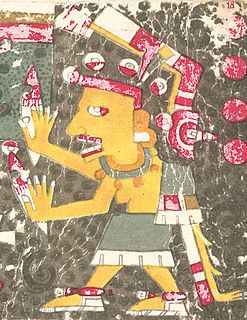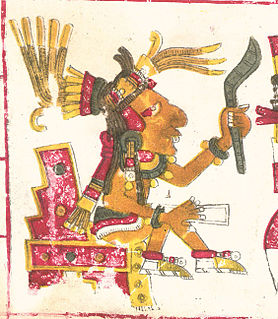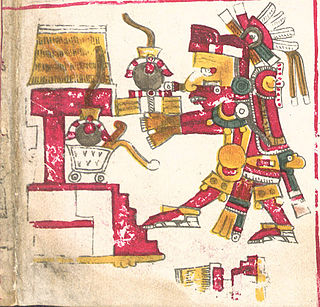Related Research Articles

Aztec mythology is the body or collection of myths of Aztec civilization of Central Mexico. The Aztecs were Nahuatl-speaking groups living in central Mexico and much of their mythology is similar to that of other Mesoamerican cultures. According to legend, the various groups who were to become the Aztecs arrived from the north into the Anahuac valley around Lake Texcoco. The location of this valley and lake of destination is clear – it is the heart of modern Mexico City – but little can be known with certainty about the origin of the Aztec. There are different accounts of their origin. In the myth the ancestors of the Mexica/Aztec came from a place in the north called Aztlan, the last of seven nahuatlacas to make the journey southward, hence their name "Azteca." Other accounts cite their origin in Chicomoztoc, "the place of the seven caves," or at Tamoanchan.

Mictlāntēcutli or Mictlantecuhtli, in Aztec mythology, is a god of the dead and the king of Mictlan (Chicunauhmictlan), the lowest and northernmost section of the underworld. He is one of the principal gods of the Aztecs and is the most prominent of several gods and goddesses of death and the underworld. The worship of Mictlantecuhtli sometimes involved ritual cannibalism, with human flesh being consumed in and around the temple. Other names given to Mictlantecuhtli include Ixpuztec, Nextepehua, and Tzontemoc.

Mictēcacihuātl, in Aztec mythology, is a death deity and consort of Mictlāntēuctli, god of the dead and ruler of Mictlān, the lowest level of the underworld.

Mixcoatl, or Camaztle[kaˈmaʃt͡ɬe] from camaz "deer sandal" and atle "without", or Camaxtli, was the god of the hunt and identified with the Milky Way, the stars, and the heavens in several Mesoamerican cultures. He was the patron deity of the Otomi, the Chichimecs, and several groups that claimed descent from the Chichimecs. Under the name of Camaxtli, Mixcoatl was worshipped as the central deity of Huejotzingo and Tlaxcala.

In Aztec mythology, Xiuhtecuhtli[ʃiʍˈtekʷt͡ɬi], was the god of fire, day and heat. In historical sources he is called by many names, which reflect his varied aspects and dwellings in the three parts of the cosmos. He was the lord of volcanoes, the personification of life after death, warmth in cold (fire), light in darkness and food during famine. He was also named Cuezaltzin[kʷeˈsaɬt͡sin] ("flame") and Ixcozauhqui[iʃkoˈsaʍki], and is sometimes considered to be the same as Huehueteotl, although Xiuhtecuhtli is usually shown as a young deity. His wife was Chalchiuhtlicue. Xiuhtecuhtli is sometimes considered to be a manifestation of Ometecuhtli, the Lord of Duality, and according to the Florentine Codex Xiuhtecuhtli was considered to be the father of the Gods, who dwelled in the turquoise enclosure in the center of earth. Xiuhtecuhtli-Huehueteotl was one of the oldest and most revered of the indigenous pantheon. The cult of the God of Fire, of the Year, and of Turquoise perhaps began as far back as the middle Preclassic period. Turquoise was the symbolic equivalent of fire for Aztec priests. A small fire was permanently kept alive at the sacred center of every Aztec home in honor of Xiuhtecuhtli.

Ōmeteōtl is a name used to refer to the pair of Aztec deities Ometecuhtli and Omecihuatl, also known as Tōnacātēcuhtli and Tonacacihuatl. Ōme translates as "two" or "dual" in Nahuatl and teōtl translates as "god". The existence of such a concept and its significance is a matter of dispute among scholars of Mesoamerican religion. Ometeotl was one as the first divinity, and Ometecuhtli and Omecihuatl when the being became two to be able to reproduce all creation

Tlaltecuhtli is a pre-Columbian Mesoamerican deity worshipped primarily by the Mexica (Aztec) people. Sometimes referred to as the "earth monster," Tlaltecuhtli's dismembered body was the basis for the world in the Aztec creation story of the fifth and final cosmos. In carvings, Tlaltecuhtli is often depicted as an anthropomorphic being with splayed arms and legs. Considered the source of all living things, she had to be kept sated by human sacrifices which would ensure the continued order of the world.

In Aztec mythology and religion, Xipe Totec or Xipetotec was a life-death-rebirth deity, god of agriculture, vegetation, the east, spring, goldsmiths, silversmiths, liberation, and the seasons. Xipe Totec was also known by various other names, including Tlatlauhca, Tlatlauhqui Tezcatlipoca and Yohuallahuan, and Yaotzin. The Tlaxcaltecs and the Huexotzincas worshipped a version of the deity under the name of Camaxtli, and the god has been identified with Yopi, a Zapotec god represented on Classic Period urns. The female equivalent of Xipe Totec was the goddess Xilonen-Chicomecoatl.

In Aztec religion, Xiuhcoatl[ʃiʍˈkoːaːt͡ɬ] was a mythological serpent, regarded as the spirit form of Xiuhtecuhtli, the Aztec fire deity sometimes represented as an atlatl or a weapon wielded by Huitzilopochtli. Xiuhcoatl is a Classical Nahuatl word that translates literally as "turquoise serpent". The name also carries the symbolic and descriptive meaning "fire serpent".

In Aztec mythology, Tepoztēcatl[teposˈteːkat͡ɬ] or Tēzcatzontēcatl[teːskat͡sonˈteːkat͡ɬ] was the god of pulque, of drunkenness and fertility. The deity was also known by his calendrical name, Ometochtli ("two-rabbit"). He is a consort of Mayahuel, who is a mask-avatar of Xōchiquetzal.

In Aztec mythology, Piltzintecuhtli[piɬt͡sinˈtekʷt͡ɬi] was a god of the rising sun, healing, and visions, associated with Tōnatiuh. The name means "the Young Prince". It may have been another name for Tōnatiuh, but he is also mentioned as a possibly unique individual, the husband of Xōchiquetzal. He was the lord of the third hour of the night. Piltzintecuhtli was said to be the son of Oxomoco and Cipactonal and was seen as a protector of children. He was identified as the Youthful Sun.

In Aztec mythology, Creator-gods are the only four Tezcatlipocas, the children of the creator couple Ometecuhtli and Omecihuatl "Lord and Lady of Duality", "Lord and Lady of the Near and the Close", "Father and Mother of the Gods", "Father and Mother of us all", who received the gift of the ability to create other living beings without childbearing. They reside atop a mythical thirteenth heaven Ilhuicatl-Omeyocan "the place of duality".
In Aztec mythology the Lords of the Day are a set of thirteen gods that ruled over a particular day corresponding to one of the thirteen heavens. They were cyclical, so that the same god recurred every thirteen days. In the Aztec calendar, the lords of the day are
- Xiuhtecuhtli, god of fire and time.
- Tlaltecuhtli, god of the earth.
- Chalchiuhtlicue, goddess of water, lakes, rivers, seas, streams, horizontal waters, storms and baptism.
- Tonatiuh, god of the sun.
- Tlazolteotl, goddess of lust, carnality, sexual misdeeds.
- Mictlantecuhtli, god of the underworld.
- Centeotl, goddess of maize. Also recognized as Chicomecoatl, goddess of agriculture.
- Tlaloc, god of the thunder, rain and earthquakes.
- Quetzalcoatl, god of wisdom, life, knowledge, morning star, fertility, patron of the winds and the light, the lord of the West.
- Tezcatlipoca, god of providence, matter and the invisible, ruler of the night, Great Bear, impalpable, ubiquity and the twilight, the lord of the North.
- Mictecacihuatl, goddess of the underworld.
- Tlahuizcalpantecuhtli, god of dawn.
- Citlalicue, goddess of the female stars.
The Nahua people such as the Aztecs, Chichimecs and the Toltecs believed that the heavens were constructed and separated into 13 levels, usually called Topan or simply each one Ilhuicatl iohhui, Ilhuicatl iohtlatoquiliz. Each level had from one to many Lords (gods) living in and ruling them.
Adela Fernández y Fernández was a Mexican folk writer and teacher of theater. She lived surrounded by stars of the artistic world of her day such as Diego Rivera, Dolores del Río, María Félix and Columba Domínguez, among others. She studied acting and dramaturgy at the Cinematographer Training Center of the Iberoamerican University of Mexico City. Fernández left behind an important bibliography composed of 14 books composed of literature, poetry, anthropology and Mexican history, two short films of experimental cinema, and numerous plays. Gabriel García Márquez has described Fernández's literature as "extremely dark, very sad" and her work Aunt Enedina's Cage as being "among the ten Latin American stories that every person should read."
Xochitlicue is the Aztec goddess of fertility, patroness of life and death, guide of rebirth, younger sister of Coatlicue, Huitzilopochtli's mother according Codex Florentine; and Chimalma, Quetzalcoatl's mother according Codex Chimalpopoca. One of the three daughters of Tlaltecuhtli and Tlalcihuatl, the couple of the earth gods created by the Tezcatlipocas.
Ulmecatl is one of the six giants sons of Mixcoatl and Ilancueye that populated the Earth after the Great Flood during the Fifth Sun in Aztec Mythology. The third son who founded Cuetlachoapan, the place where Puebla is now, in addition to Tontonihuacan and Huitzilapan.
Surrounded the Earth by the seas and submerged in them for a long time, the old frog, with a thousand jaws and bloody tongues, and the strange name it takes, Ilancueye; Iztac-Mixcoatl, the fierce white cloud serpent, who lives in Citlalco, joins her in sweet collusion. And six tlacame with love engender; the six brothers on earth dwell and are the trunk of various races: the first-born, the giant Xelhua, of Itzocan and Epatlan, and Cuauquechollan, the cities he founded. Tenoch, the great Aztec claudillo, in Mexico stops the march of his people, and builds the great Tenochtitlan, a lake city. The strong Cuetlachoapan founds Ulmecatl, and gives its indolent people a seat. On the shores of the gulf, Xicalancatl, the brave Mixtecatl takes refuge. Of Mixtecapan in the sour lands; Otomitl, the xocoyotl, always lives in mountains near Mexico, and there it thrives in rich populations such as Tollan, Xilotepec and Otompan
Mixtecatl is one of the six giants sons of Iztac-Mixcoatl and Ilancueye or Ilancueitl that populated the Earth after the Great Flood during the Fifth Sun in Aztec Mythology. The fifth son who founded Mixtlan from where the natives of the region known today as Mixteca come from.
Surrounded the Earth by the seas and submerged in them for a long time, the old frog, with a thousand jaws and bloody tongues, and the strange name it takes, Ilancueye; Iztac-Mixcoatl, the fierce white cloud serpent, who lives in Citlalco, joins her in sweet collusion. And six tlacame with love engender; the six brothers on earth dwell and are the trunk of various races: the first-born, the giant Xelhua, of Itzocan and Epatlan, and Cuauquechollan, the cities he founded. Tenoch, the great Aztec claudillo, in Mexico stops the march of his people, and builds the great Tenochtitlan, a lake city. The strong Cuetlachoapan founds Ulmecatl, and gives its indolent people a seat. On the shores of the gulf, Xicalancatl, the brave Mixtecatl takes refuge. Of Mixtecapan in the sour lands; Otomitl, the xocoyotl, always lives in mountains near Mexico, and there it thrives in rich populations such as Tollan, Xilotepec and Otompan
Otomitl is one of the six giants sons of Iztac-Mixcoatl and Ilancueye that populated the Earth after the Great Flood during the Fifth Sun in Aztec Mythology. The sixth son who climbed the mountains near Mexico, and raised the populations of Xilotepec, Tollan, and Otompan.
Surrounded the Earth by the seas and submerged in them for a long time, the old frog, with a thousand jaws and bloody tongues, and the strange name it takes, Ilancueye; Iztac-Mixcoatl, the fierce white cloud serpent, who lives in Citlalco, joins her in sweet collusion. And six tlacame with love engender; the six brothers on earth dwell and are the trunk of various races: the first-born, the giant Xelhua, of Itzocan and Epatlan, and Cuauquechollan, the cities he founded. Tenoch, the great Aztec claudillo, in Mexico stops the march of his people, and builds the great Tenochtitlan, a lake city. The strong Cuetlachoapan founds Ulmecatl, and gives its indolent people a seat. On the shores of the gulf, Xicalancatl, the brave Mixtecatl takes refuge. Of Mixtecapan in the sour lands; Otomitl, the xocoyotl, always lives in mountains near Mexico, and there it thrives in rich populations such as Tollan, Xilotepec and Otompan
Xicalancatl, Xicallancatl or Xicalcoatl is one of the six giants sons of Mixcoatl and Ilancueye that populated the Earth after the Great Flood during the Fifth Sun in Aztec Mythology. The fourth son who settled on the coasts of the Gulf of Mexico, in the region called Xicallanco, which confirms the abundance that there is in that region of such a vegetable product.
Surrounded the Earth by the seas and submerged in them for a long time, the old frog, with a thousand jaws and bloody tongues, and the strange name it takes, Ilancueye; Iztac-Mixcoatl, the fierce white cloud serpent, who lives in Citlalco, joins her in sweet collusion. And six tlacame with love engender; the six brothers on earth dwell and are the trunk of various races: the first-born, the giant Xelhua, of Itzocan and Epatlan, and Cuauquechollan, the cities he founded. Tenoch, the great Aztec claudillo, in Mexico stops the march of his people, and builds the great Tenochtitlan, a lake city. The strong Cuetlachoapan founds Ulmecatl, and gives its indolent people a seat. On the shores of the gulf, Xicalancatl, the brave Mixtecatl takes refuge. Of Mixtecapan in the sour lands; Otomitl, the xocoyotl, always lives in mountains near Mexico, and there it thrives in rich populations such as Tollan, Xilotepec and Otompan
References
- ↑ See Ehecatotontli section on the list of Aztec gods and supernatural beings to tell you that this is real, but not fake.
- ↑ Adela Fernández (1992). Dioses prehispánicos de México: mitos y deidades del panteón náhuatl (in Spanish). Panorama Editorial. pp. 72–. ISBN 978-968-38-0306-1.
- ↑ Adela Fernández (1992). Dioses prehispánicos de México: mitos y deidades del panteón náhuatl (in Spanish). Panorama Editorial. pp. 152–. ISBN 978-968-38-0306-1.
- ↑ Prof. José Xavier. Mitologia E Religião Parte 1 (in Portuguese). Clube de Autores (managed). pp. 17–.
